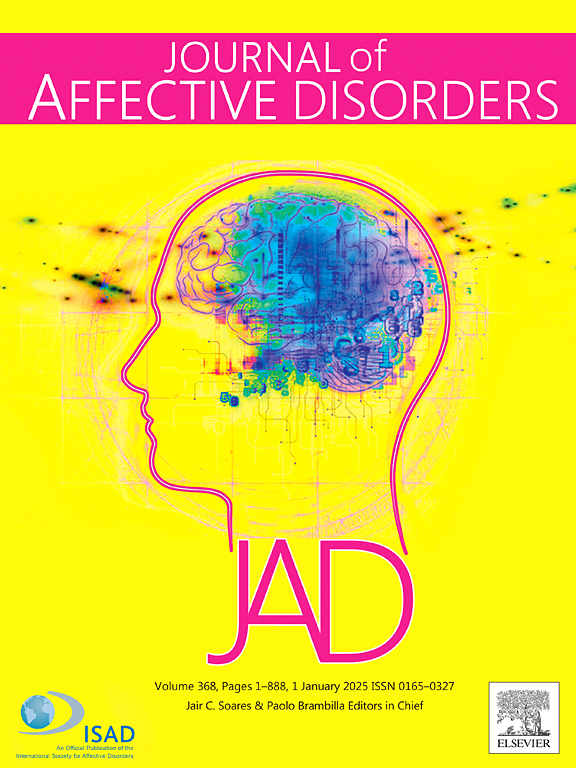Interaction among negative mood, sleep, and diet habits in adolescents with non-suicidal self-injury: A cross-sectional network analysis
IF 4.9
2区 医学
Q1 CLINICAL NEUROLOGY
引用次数: 0
Abstract
Background
Non-suicidal self-injury (NSSI) is a serious public health problem that can lead to adverse effects such as cognitive impairment, poor interpersonal relationships and violent crime. The progress of preventing and treating NSSI in adolescents depends on other changeable risk factors, such as negative mood, sleep, and diet habits. However, the risk factors for adolescent NSSI remain unclear. Therefore, this study explores the key factors influencing adolescents' NSSI behavior through the use of network analysis.
Methods
The study recruited 4040 middle school students aged 12–18 years old. From November 1st, 2023 to January 1st, 2024, paper questionnaires were utilized to investigate the participants' basic conditions, negative mood, NSSI, sleep conditions, and diet habits. Network analysis was used to explore the interrelationship among risk factors and discover the core factor.
Results
In the network structure of adolescents with NSSI behavior, the most correlated nodes were negative emotions (CDI2) and low self-esteem (CDI3). Compared with adolescents without NSSI behavior, adolescents with NSSI behavior showed prominent anxiety symptoms related to injury avoidance (MASC1) and social anxiety (MASC2). Anhedonia (CDI1) was both the central node and the bridge node of the network.
Limitation
The cross-sectional design of this study couldn't clarify the causal inference between independent variables and results.
Conclusion
Anhedonia is the key factor affecting adolescents' emotion regulation. Furthermore, we hypothesize that adolescent NSSI is an emotional disorder, and anhedonia plays an important role in preventing and intervening in adolescents' NSSI behavior.
非自杀性自伤青少年的负面情绪、睡眠和饮食习惯之间的相互作用:横断面网络分析
背景:非自杀性自伤(NSSI)是一个严重的公共卫生问题,可导致认知障碍、人际关系不良和暴力犯罪等不良后果。预防和治疗青少年 NSSI 的进展取决于其他可改变的风险因素,如负面情绪、睡眠和饮食习惯。然而,青少年 NSSI 的风险因素仍不明确。因此,本研究通过网络分析法探讨影响青少年非自杀性自残行为的关键因素:本研究招募了 4040 名 12-18 岁的中学生。从 2023 年 11 月 1 日至 2024 年 1 月 1 日,利用纸质问卷调查了参与者的基本情况、消极情绪、NSSI、睡眠状况和饮食习惯。采用网络分析法探讨危险因素之间的相互关系,发现核心因素:在有 NSSI 行为的青少年的网络结构中,最相关的节点是消极情绪(CDI2)和自卑(CDI3)。与无 NSSI 行为的青少年相比,有 NSSI 行为的青少年表现出的焦虑症状主要与避免受伤(MASC1)和社交焦虑(MASC2)有关。失乐症(CDI1)既是网络的中心节点,也是网络的桥梁节点:本研究的横断面设计无法明确自变量与结果之间的因果关系:失乐症是影响青少年情绪调节的关键因素。此外,我们假设青少年非自杀性自伤是一种情绪障碍,而失乐症在预防和干预青少年非自杀性自伤行为中发挥着重要作用。
本文章由计算机程序翻译,如有差异,请以英文原文为准。
求助全文
约1分钟内获得全文
求助全文
来源期刊

Journal of affective disorders
医学-精神病学
CiteScore
10.90
自引率
6.10%
发文量
1319
审稿时长
9.3 weeks
期刊介绍:
The Journal of Affective Disorders publishes papers concerned with affective disorders in the widest sense: depression, mania, mood spectrum, emotions and personality, anxiety and stress. It is interdisciplinary and aims to bring together different approaches for a diverse readership. Top quality papers will be accepted dealing with any aspect of affective disorders, including neuroimaging, cognitive neurosciences, genetics, molecular biology, experimental and clinical neurosciences, pharmacology, neuroimmunoendocrinology, intervention and treatment trials.
 求助内容:
求助内容: 应助结果提醒方式:
应助结果提醒方式:


